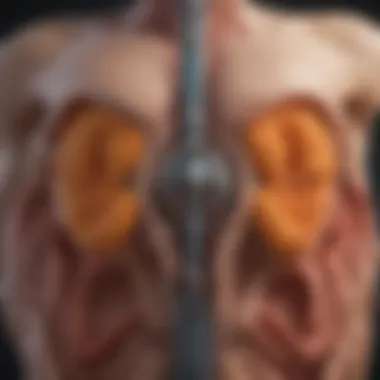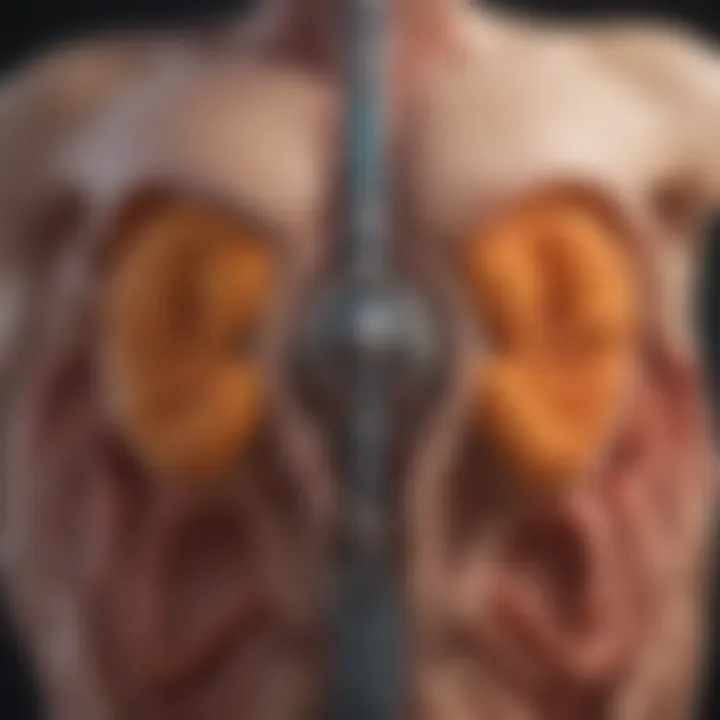Myasthenia Gravis and Overactive Bladder Insights


Intro
Myasthenia gravis and overactive bladder represent two distinct medical conditions, yet they frequently coexist, creating a conundrum for patients and healthcare providers. Understanding how these diseases interact is crucial for appropriate diagnosis, treatment, and overall patient care. The complexities of these conditions require interdisciplinary collaboration, as insights from neurology, urology, and other medical fields are necessary to develop effective management strategies.
This analysis will delve into the intricate relationship between myasthenia gravis, a chronic autoimmune disorder marked by weakness in voluntary muscles, and overactive bladder, characterized by a sudden urge to urinate frequently. This intersection sheds light on shared neurological pathways and treatment challenges, fostering a comprehensive understanding that could enhance patient quality of life.
Overview of Research Topic
Brief Background and Context
The pathophysiology of myasthenia gravis involves the body's immune system attacking communication between nerves and muscles. This condition leads to muscle weakness, often affecting limbs and facial muscles. Conversely, overactive bladder stems from neurological irregularities that affect bladder control, causing involuntary contractions of the bladder muscle. The coexistence of these conditions raises questions about the underlying mechanisms that may contribute to their prevalence together.
Importance in Current Scientific Landscape
Recognizing the comorbidity of myasthenia gravis and overactive bladder is vital in the contemporary scientific discourse. Insights from recent research emphasize the need for a holistic approach in treatment protocols. Understanding these interactions has implications for personalized patient care, affecting everything from medication selection to lifestyle recommendations. Moreover, as improvements in diagnostic techniques enhance detection rates, it is increasingly important for practitioners to consider these two conditions in tandem.
Methodology
Research Design and Approach
This article employs a comprehensive literature review, analyzing peer-reviewed articles, clinical studies, and relevant case reports to illuminate the intersection of myasthenia gravis and overactive bladder. By synthesizing findings from various disciplines, this analysis seeks to create a more nuanced view of how these conditions co-occur and the implications for patient management.
Data Collection Techniques
Data will be gathered from multiple sources. The search will encompass
- Medical journals, such as Neurology and Urology
- Databases including PubMed and Google Scholar
- Professional guidelines from organizations like the American Academy of Neurology and the Urological Society.
This meticulous approach ensures a robust understanding of the interplay between these two conditions, providing valuable insights for patients and healthcare providers alike.
Preamble to Myasthenia Gravis and Overactive Bladder
The correlation between myasthenia gravis (MG) and overactive bladder (OAB) represents a nuanced and complex intersection of two distinct clinical conditions. Understanding these interactions is critical for healthcare providers and researchers involved in patient care. By examining the unique characteristics of both MG and OAB, the implications for treatment and management can be better understood. This section highlights the importance of addressing these conditions together, particularly regarding the challenges faced by patients who endure both.
Overview of Myasthenia Gravis
Myasthenia gravis is a chronic autoimmune disorder primarily characterized by weakness in voluntary muscles. This weakness stems from a breakdown in the communication between nerves and muscles. In MG, antibodies disrupt the transmission of messages at the neuromuscular junction, leading to fatigue and muscle weakness. Symptoms often fluctuate and can worsen after periods of exertion, creating additional barriers to diagnosis and treatment.
The condition affects people of all ages but tends to commonly present in younger women and older men. While some individuals may experience sporadic symptoms, others may face a progressive course that can significantly impact their quality of life. Furthermore, the psychosocial aspects of living with MG can add to the complexity of patient care, making it imperative for healthcare professionals to adopt a holistic approach.
Understanding Overactive Bladder
Overactive bladder is a condition marked by an urgent need to urinate, often accompanied by increased frequency and potential incontinence. It results from involuntary contractions of the detrusor muscle in the bladder, which can lead to a debilitating impact on daily living. Symptoms can range from mild urgency to severe disruptions in activities and sleep.
This condition can occur independently or coexist with other medical issues, including myasthenia gravis. The interplay between OAB and MG can complicate the management strategies for both disorders. In particular, the medications used to treat each condition may affect the other, prompting urgent discussions among healthcare providers.
In summary, focusing on the understanding of myasthenia gravis and overactive bladder offers crucial insights for patient care. Better awareness allows improved solutions to address both conditions and enhances the quality of life for individuals living with this dual burden.
Pathophysiology of Myasthenia Gravis
Understanding the pathophysiology of Myasthenia Gravis is crucial for comprehending how the disease manifests and affects patients. Myasthenia Gravis is an autoimmune neuromuscular disorder that leads to varying degrees of muscle weakness. This section examines the underlying mechanisms that contribute to the disease's progression, focusing on two primary aspects: autoimmune mechanisms and neuromuscular junction dysfunction. Recognizing these mechanisms allows for improved treatment strategies and a better quality of life for those afflicted.
Autoimmune Mechanisms
Myasthenia Gravis primarily arises from an autoimmune response. In this condition, the body's immune system mistakenly targets its own tissues. Specifically, antibodies are produced against acetylcholine receptors located at the neuromuscular junction. These receptors are essential for muscle contraction, as they mediate the connection between nerve impulses and muscle fibers.
When antibodies bind to these receptors, several harmful effects occur. First, the number of functional acetylcholine receptors decreases, reducing the muscle's ability to respond to signals from the nervous system. Second, the binding of antibodies can trigger inflammation and damage to the postsynaptic membrane, leading to further impairment of neuromuscular transmission. It is important to note that this autoimmune response isn't universal; nearly 85% of patients develop antibodies against acetylcholine receptors, but some may produce antibodies against muscle-specific kinase, leading to a different presentation of symptoms.
The pathogenic role of these antibodies significantly impacts day-to-day functioning. Symptoms often include fatigue and weakness, which may worsen with activity. Understanding the autoimmune mechanisms involved can help healthcare professionals manage symptoms more effectively and tailor treatment to the specific needs of patients.
Neuromuscular Junction Dysfunction
The neuromuscular junction is a critical site where nerves stimulate muscles to contract. In Myasthenia Gravis, dysfunction at this junction results from the autoimmune attack previously discussed. The reduction of acetylcholine receptors leads to impaired synaptic transmission at the neuromuscular junction.
This dysfunction is characterized by a failure to effectively transmit nerve impulses to muscle fibers, causing weakness and fatigability. The severity of this dysfunction can vary significantly among individuals. Some might experience mild muscle fatigue, while others may suffer from profound weakness affecting various muscle groups, including those responsible for breathing and swallowing.
Moreover, muscle weakness in Myasthenia Gravis tends to present in a fluctuating pattern. Issues may occur in ocular muscles, leading to ptosis or diplopia, and proximal limb muscles are often more affected than distal ones. The understanding of neuromuscular junction dysfunction is critical for recognizing the specific muscular abnormalities present in Myasthenia Gravis, and thus, it helps inform treatment options.
In summary, the autoimmune mechanisms and neuromuscular junction dysfunction are fundamental to the pathophysiology of Myasthenia Gravis. Recognizing these elements can provide insight into the nature of the disease, leading to more effective management strategies for patients.
Pathophysiology of Overactive Bladder
Understanding the pathophysiology of overactive bladder (OAB) is crucial in this analysis, especially in how it may interact with myasthenia gravis. OAB is a condition characterized by a sudden, uncontrollable urge to urinate that often leads to frequent urination. The underlying mechanisms can significantly affect treatment options and patient experiences. A comprehensive grasp of these mechanisms helps healthcare professionals tailor interventions, making it vital for managing patients experiencing both conditions.
Detrusor Muscle Overactivity
One of the primary components in the pathology of overactive bladder is the detrusor muscle. The detrusor is the smooth muscle that forms the wall of the bladder. In healthy individuals, this muscle remains relaxed during the bladder’s filling phase. However, for individuals with OAB, the detrusor muscle may exhibit hyperactivity. This leads to contractions that occur even when the bladder is not full.


Several factors can contribute to detrusor overactivity.
- Neurogenic origins: Changes or damage in the nervous system can trigger involuntary contractions. This response may occur because of neurological conditions or injury.
- Inflammation: Conditions that cause bladder wall inflammation can alter signaling pathways, exacerbating the overactive response.
- Hormonal factors: Fluctuations in sex hormones may also influence bladder activity, particularly in women during menopause.
When the detrusor muscle contracts excessively, it results in symptoms of urgency, frequency, and, in some cases, incontinence. Recognizing these symptoms as part of a broader profile involving myasthenia gravis can support a more effective management strategy, particularly in choosing appropriate treatment options.
Neurological Factors
The neurological underpinnings of OAB are equally critical to understanding this condition. The bladder is controlled by a complex interplay of central and peripheral nervous systems. Disruption in these neural pathways can result in OAB symptoms.
- Central Nervous System: The brain-based control of bladder function can be impaired by conditions such as stroke, multiple sclerosis, or even brain injuries. Such impairment can lead to miscommunication between the bladder and the brain, prompting inappropriate bladder contractions.
- Peripheral Nervous System: Damage to the nerves that transmit signals to and from the bladder can also affect its function. In conditions like myasthenia gravis, where neuromuscular communication is already compromised, the risk of developing OAB symptoms increases.
Additionally, psychological factors can influence bladder function. Anxiety and stress can exacerbate urgency and frequency, further complicating management in patients experiencing overlaps of these two conditions.
Understanding these diverse aspects of overactive bladder is key in developing interdisciplinary treatment plans. Addressing both detrusor muscle mechanics and neurological influences allows for a comprehensive strategy that can enhance patient outcomes.
Epidemiology of Myasthenia Gravis and Overactive Bladder
Understanding the epidemiology of myasthenia gravis and overactive bladder is essential for healthcare professionals and researchers alike. The knowledge gained from epidemiological studies allows for more informed decisions regarding diagnosis, treatment, and management of these coexisting conditions. Various factors such as demographics, geographical distribution, and the burden of these diseases can influence the way they are understood and treated.
Myasthenia gravis, an autoimmune disorder characterized by weakness in voluntary muscles, often requires coordinated healthcare strategies due to its complexities. On the other hand, overactive bladder, marked by symptoms of urinary urgency, has significant implications for quality of life. Recognizing how prevalent these conditions are can lead to improved awareness and better resource allocation in clinical practices.
Prevalence of Myasthenia Gravis
Myasthenia gravis has a variable prevalence depending on geographic regions and population demographics. Recent studies estimate that myasthenia gravis affects approximately 14 to 20 individuals per 100,000 people in the general population. The incidence tends to be higher in women than in men, with a notable peak occurring in young adulthood and a second peak noted in older adults.
The prevalence of myasthenia gravis can fluctuate due to factors such as environmental triggers or genetic predispositions. Furthermore, the disease may go unrecognized in some populations, leading to underreporting.
- Myasthenia gravis is more common in women under 40 and men over 60.
- Geographic factors can also play a role, with higher rates reported in regions such as North America and Northern Europe.
- Increased awareness among physicians has allowed for better identification and management of this condition over recent years.
The timely diagnosis of myasthenia gravis can significantly improve patient outcomes and quality of life.
Prevalence of Overactive Bladder
Overactive bladder is a common condition affecting both genders, although studies often indicate a higher prevalence in women. In the United States, estimates suggest that overactive bladder impacts around 16% of adults, translating to more than 30 million people. The likelihood of developing overactive bladder increases with age, with a notable rise in prevalence observed in those aged 65 years and older.
- Men are generally affected less than women until older age, where prevalence rates converge.
- Global prevalence of overactive bladder varies, with instances shown to be higher in developed countries compared to developing ones.
- Risk factors for overactive bladder include obesity, diabetes, and neurological disorders.
Effective management of overactive bladder is crucial as it can lead to significant emotional and physical burdens on patients. Thus, continuous research into its prevalence helps shape treatment guidelines and improve patient education.
Clinical Implications of Coexisting Conditions
Understanding the clinical implications of coexisting conditions like Myasthenia Gravis and overactive bladder is crucial for effective patient management. These conditions interact in complex ways, affecting not only diagnosis but also treatment strategies and overall patient well-being. Healthcare providers must consider the full spectrum of symptoms and treatment effects when addressing such coexisting conditions. The goal is to optimize patient care by addressing individual needs holistically, which can lead to improved outcomes and quality of life.
Symptoms Overlap
One of the key challenges in managing Myasthenia Gravis and overactive bladder arises from the overlapping symptoms. Fatigue, muscle weakness, and urinary urgency are common in both conditions, leading to potential misdiagnosis or delayed treatment. The direct impact of muscle weakness on bladder control can complicate the clinical picture. For instance, patients may present with increased urinary frequency, which can be mistakenly attributed solely to overactive bladder without considering the contributing role of muscle weakness from Myasthenia Gravis.
The overlap in symptoms necessitates careful evaluation and monitoring. Patients should have a thorough assessment of neurological and urinary symptoms to distinguish between the two conditions effectively.
"Integrating interdisciplinary knowledge is key to managing patients with multiple conditions effectively."
Impact on Daily Living
The presence of both Myasthenia Gravis and overactive bladder can significantly affect a patient's daily living. Individuals often face increased challenges in routine tasks. The physical limitations brought by muscle weakness intersect with the psychological burden of managing urinary urgency and incontinence. This duality can lead to social isolation, anxiety, and depression, further complicating the patient’s health status.
Healthcare providers must address these aspects during treatment planning. Effective communication about symptoms and their impact on life will enable more tailored interventions.
Considerations for daily living impacts should include:
- Scheduling Flexibility: Patients may require flexible work or life schedules to manage fatigue effectively.
- Support Systems: Encourage family and community involvement to combat feelings of isolation.
- Tailored Treatment Plans: Create individualized management strategies that take into account the dual diagnosis, ensuring both conditions are treated effectively.
In summary, recognizing the clinical implications of coexisting Myasthenia Gravis and overactive bladder is essential for delivering patient-centered care that upholds the dignity and quality of life for individuals facing these challenges.
Current Treatment Approaches for Myasthenia Gravis
Understanding the treatment approaches for myasthenia gravis is vital for managing this condition effectively. Myasthenia gravis can significantly impact a patient's quality of life. Treatment options aim to reduce symptoms and improve muscle strength. Here we will explore two main areas: pharmacological interventions and surgical options.
Pharmacological Interventions
Pharmacological treatments are often the first line of defense against myasthenia gravis. They primarily focus on enhancing communication between nerves and muscles. The most common medications include:
- Acetylcholinesterase inhibitors: Drugs like pyridostigmine are used to increase neurotransmitter availability, thus improving muscle contractions. This can provide significant relief for many patients.
- Immunosuppressive agents: Medications such as azathioprine, mycophenolate mofetil, and prednisone help regulate the immune system. These drugs prevent the body from attacking its own receptors, which are crucial for muscle function. Their use, however, can vary based on individual patient characteristics.
- Monoclonal antibodies: Newer treatments, like rituximab, have shown promise in those who do not respond well to traditional options. These medications target specific components of the immune response, providing an alternative pathway for management.
Each medication has its own side effects and benefits, which need to be discussed with healthcare providers. The choice of pharmacological intervention often depends on the severity of symptoms and patient preferences.
Surgical Options
In some cases, surgical intervention may be necessary. Thymectomy, the surgical removal of the thymus gland, can result in significant improvements for many patients. This option is particularly relevant for individuals with a thymoma or those who have generalized myasthenia gravis. The potential benefits of thymectomy include:


- Symptom improvement: Many patients report a reduction in muscle weakness post-surgery.
- Decreased medication reliance: Following thymectomy, some patients may be able to reduce or eliminate the need for certain medications.
- Long-term remission: In some cases, surgical patients experience long-lasting remission of symptoms.
It is important to weigh the risks against the potential benefits of surgery. Not all patients are candidates for thymectomy, and decisions should be made jointly by the patient and a specialized medical team.
Current Treatment Approaches for Overactive Bladder
The topic of Current Treatment Approaches for Overactive Bladder (OAB) is significant in the context of its intersection with myasthenia gravis. Patients grappling with both conditions often face compounded challenges in managing their symptoms. Understanding the treatment landscape for OAB is essential to optimize care for these individuals. This section will detail the various methods available to manage OAB effectively, highlighting their benefits and considerations.
Behavioral Therapies
Behavioral therapies play a crucial role in treating Overactive Bladder. They focus on lifestyle modifications and strategic bladder management techniques, which can be particularly effective. These approaches are non-intrusive and can often be integrated alongside pharmacological treatments.
Some common behavioral strategies include:
- Bladder Training: This involves scheduled voiding to gradually extend the time between bathroom trips. Patients learn to retrain their bladder to hold more urine.
- Pelvic Floor Exercises: Strengthening pelvic floor muscles can enhance bladder control, reducing urgency and frequency.
- Dietary Modifications: Avoiding irritants, such as caffeine and alcohol, may lessen symptoms. A tailored diet can significantly improve overall bladder health.
One of the primary benefits of behavioral therapies is their accessibility. Many patients can implement these techniques with or without direct supervision from healthcare providers. Moreover, they offer a foundation that supports other treatment modalities, potentially enhancing their effects.
"Incorporating behavioral therapies can result in improved bladder function and quality of life for patients suffering from OAB."
Nevertheless, adherence to these strategies can be challenging. Patient motivation is key, and some individuals may require additional support or encouragement to maintain new habits.
Medications for Overactive Bladder
Medication options for Overactive Bladder are diverse, aiming to mitigate symptoms by targeting the bladder's hyperactivity. Antimuscarinics and beta-3 agonists are the most commonly prescribed classes of medications.
- Antimuscarinics: These drugs, such as oxybutynin and tolterodine, work by blocking muscarinic receptors, reducing involuntary contractions of the bladder. They can provide significant symptom relief but may have side effects like dry mouth and constipation.
- Beta-3 Agonists: Medications like mirabegron relax the detrusor muscle during the filling phase, which can increase bladder capacity and decrease urgency. They are often preferable for patients who cannot tolerate antimuscarinics.
When starting these medications, it is essential for healthcare providers to consider potential interactions with treatments for myasthenia gravis. The choice of drug may have implications on symptom control and overall well-being.
Additional considerations include dosage adjustments based on patient response and tolerability. Some patients might experience side effects that warrant switching medications or combining treatments for optimal control. It is vital to have open communication between patients and healthcare professionals to tailor the approach effectively.
Challenges in Managing Myasthenia Gravis and Overactive Bladder
Managing both myasthenia gravis and overactive bladder presents unique challenges. The co-existence of these conditions complicates diagnosis and treatment. When a patient presents symptoms related to both disorders, distinguishing between them becomes difficult. This can lead to mismanagement or a delay in appropriate care. Health care professionals must be aware of the interplay between myasthenia gravis and overactive bladder.
Several factors contribute to the challenges in treating these conditions concurrently. First, the treatment options for each disorder often intersect and may conflict. For instance, medications prescribed for myasthenia gravis could potentially exacerbate urinary symptoms or vice versa. Additionally, the chronic nature of both diseases can impact the overall quality of life for patients, as they manage multiple symptoms.
Furthermore, there is limited research specifically addressing the intersection of these two conditions. This lack of focused studies may lead to uncertainties in treatment protocols, leaving both patients and practitioners navigating through a landscape of best practices that are not well-defined. Understanding these challenges is crucial for optimizing patient care and ensuring better health outcomes.
Interaction of Treatments
The interaction of treatments for myasthenia gravis and overactive bladder can be complicated. Patients often take multiple medications, each aimed at addressing specific symptoms. For instance, cholinesterase inhibitors like pyridostigmine are fundamental in treating myasthenia gravis. However, these medications can have side effects that may worsen bladder control.
On the other hand, medications like antimuscarinics, which are used for overactive bladder, can have muscle-relaxant effects that may complicate neuromuscular transmission in myasthenia gravis patients. Health practitioners should closely monitor patients for signs of exacerbation in either condition when changes in medication are made. Regular consultations and thorough reviews of all medications are essential to mitigate potential interactions.
Despite these challenges, interdisciplinary approaches involving neurologists and urologists can foster better management strategies.
Patient Adherence Issues
Adherence to treatment plans is another crucial challenge faced by patients with both myasthenia gravis and overactive bladder. Patients often have to juggle complex regimens, which can lead to confusion and frustration. When medications from multiple specialists are involved, the risk of non-adherence increases.
Patients might experience side effects from different medications, leading them to skip doses or abandon their treatment altogether. This is particularly concerning for patients on myasthenia gravis treatments, where consistency can significantly impact muscle strength and fatigue levels.
Education and support systems are vital in addressing adherence challenges. Health care providers need to ensure that patients fully understand their treatment options, the importance of adherence, and how to manage the interplay between their medications effectively. Support groups or educational resources about living with both conditions can also enhance patient engagement and commitment to treatment plans.
Research Advances in Myasthenia Gravis
Research on myasthenia gravis has evolved significantly in recent years. The exploration of new therapies and genetic studies has brought hope to those affected by this chronic autoimmune disorder. Myasthenia gravis primarily disrupts communication between nerves and muscles, leading to muscle weakness. Understanding recent advances is essential for improving patient outcomes and developing targeted interventions.
Emerging Therapies
Recent advancements in therapy for myasthenia gravis focus largely on enhancing the immune system's response. One notable area of interest is the development of monoclonal antibodies. These targeted medications, such as eculizumab and rituximab, have shown promising results. They work by disrupting the immune attack on the neuromuscular junction. Researchers are exploring additional monoclonal antibodies to determine their effectiveness and safety across diverse patient populations.
Furthermore, complementary therapies are gaining traction. Oral supplements and specific dietary modifications may support muscle function and reduce symptoms. While data is still emerging, initial studies indicate varing degrees of success. This reflects a vital shift towards personalized medicine, where treatment can be tailored to the patient's unique genetic and environmental factors.
Genetic Studies
Genetics play a pivotal role in myasthenia gravis. Understanding the underlying genetic predisposition helps in recognizing the disease more accurately. Recent studies have identified certain gene markers associated with a higher risk of developing this condition.
For instance, abnormal variations in the CHRNA1 gene have been linked to severe forms of myasthenia gravis. Identification of these genetic markers allows for earlier intervention and better management strategies. Genetic research also paves the way for new treatment developments, potentially addressing the root causes rather than just mitigating symptoms.
Research Advances in Overactive Bladder
The study of overactive bladder (OAB) has evolved significantly in recent years, shedding light on novel treatment modalities that could alter patient outcomes. This section discusses recent advances in OAB research, emphasizing their implications for clinical practice and patient care.
Novel Pharmacological Approaches


Recent research has unveiled a range of novel pharmacological agents that enhance treatment for overactive bladder. These new medications offer potential benefits that go beyond what standard treatments can provide. Some of these advancements include:
- Beta-3 Adrenergic Agonists: Medications like mirabegron target beta-3 receptors in the bladder, leading to relaxation of the detrusor muscle during bladder filling. Clinical trials have shown that they can improve symptoms without the common side effects associated with anticholinergic drugs.
- Combination Therapies: Some studies explore the efficacy of combining medications. For example, the synergistic effects of mirabegron and anticholinergic drugs have been investigated to see if they can provide additional symptom relief for patients not sufficiently helped by monotherapy.
- Novel Anticholinergic Formulations: Newer formulations that offer extended-release or lower side-effect profiles can enhance adherence and symptom management in patients. Such medications are designed to minimize anticholinergic burden while maximizing bladder control.
The introduction of these pharmacological approaches allows clinicians to tailor treatments based on specific patient needs, improving adherence and potentially enhancing quality of life.
Interventional Techniques
Interventional techniques represent another front in the management of overactive bladder. These approaches can be suitable for patients who do not respond to conventional pharmacotherapy. Key advancements in this area include:
- Neuromodulation: Sacral nerve stimulation (SNS) has gained traction as an effective treatment option for OAB. This technique involves implanting a device that sends electrical impulses to the sacral nerve, which regulates bladder function. It has been shown to reduce urgency and frequency in patients with refractory symptoms.
- Botulinum Toxin Injections: OnabotulinumtoxinA, commonly referred to as Botox, has been utilized within the bladder to manage OAB. Studies indicate that these injections can significantly reduce episodes of incontinence and urgency. The effect can last for several months, prompting consideration for repeat treatments.
- Surgical Interventions: For some patients, surgical options such as bladder augmentation or minimally invasive procedures may be considered. These options are usually explored after other treatments have failed but can provide lasting relief for chronic symptoms.
In summary, advancements in pharmacological and interventional techniques for overactive bladder signify important progress in the understanding and treatment of this condition. The implications for future research are profound, and the focus should continue on integration of these approaches as ways to improve patient care and outcomes.
Future Directions in Research
The topic of future directions in research is crucial in understanding the interplay between myasthenia gravis and overactive bladder. As these two conditions can significantly impact patient well-being, identifying new pathways for investigation offers the potential to improve treatment strategies, outcomes, and patients' quality of life. Researchers must focus on both integrative approaches and personalized medicine, as both could reshape current paradigms in the management of these complex conditions.
Integrative Approaches
Integrative approaches involve the combination of treatments and methodologies that encompass the multifaceted nature of myasthenia gravis and overactive bladder. This can include collaboration across various medical disciplines, such as neurology, urology, and immunology.
By exploring integrative research models, clinicians can better understand how these conditions coexist and affect each other. Studies that evaluate the effects of myasthenia gravis therapies on bladder function and vice versa can offer insights into managing both conditions effectively.
Additionally, facilitating enhanced communication between specialists can lead to a more cohesive and holistic treatment strategy. Research in integrative approaches should focus on the following:
- Longitudinal studies to track changes in symptoms when treatments for one condition are introduced or adjusted.
- Collaborative trials that evaluate combined therapies for better outcomes.
- Engagement with patients to assess their subjective experiences of managing both conditions simultaneously.
Personalized Medicine
Personalized medicine represents a transformative shift toward tailored treatment strategies. In the context of myasthenia gravis and overactive bladder, this approach emphasizes understanding the individual characteristics of each patient. By focusing on genetic, environmental, and lifestyle factors, researchers can customize therapies that align better with a patient’s profile.
The implementation of personalized medicine involves:
- Genetic profiling to determine predispositions to either condition and how treatments might be better suited.
- Assessment of individual response to various pharmacological interventions to minimize side effects and enhance efficacy.
- Stakeholder engagement, drawing from patient feedback to guide and refine treatment protocols.
Research efforts focused on personalized medicine can lead to more effective interventions for patients with coexisting myasthenia gravis and overactive bladder. Ultimately, the path forward requires a commitment to understanding these conditions not just in isolation, but as part of a comprehensive view of patient health.
Collaborative research holds the key to developing new standards in treating coexisting conditions, offering hope for improved health outcomes.
Patient Education and Resources
Patient education plays a crucial role in managing chronic conditions like myasthenia gravis and overactive bladder. Understanding the intricacies of these medical issues fosters better patient engagement and compliance in treatment plans. When patients are well-informed, they can take proactive steps in their care, leading to better health outcomes.
In the context of myasthenia gravis, education helps patients recognize symptoms and understand the variations in disease progression. Knowledge about available treatments and when to seek medical advice empowers patients. Similarly, in overactive bladder management, being informed about triggers, lifestyle adjustments, and treatment options can significantly enhance a patient's quality of life.
Support Groups
Support groups are invaluable resources for those dealing with myasthenia gravis and overactive bladder. These groups provide a platform where individuals can share experiences, coping strategies, and emotional support. Connecting with others who face similar challenges reduces feelings of isolation and anxiety.
Support groups often host meetings, both virtually and in person, where educational sessions might be conducted. These settings allow participants to learn not only from healthcare professionals but also from each other. Additionally, knowledge shared in these groups can inspire new ideas for self-management and advocate for improved healthcare services.
Some notable support organizations include:
- Myasthenia Gravis Foundation of America
- National Association for Continence
These organizations often provide online forums, resources for local meetings, and even one-on-one support. This makes peer support more accessible and impactful.
Educational Materials
Educational materials serve as essential tools for patients and families to grasp the complexities of myasthenia gravis and overactive bladder. Fact sheets, brochures, and online resources can clarify what to expect from diagnoses and treatments. These materials typically cover crucial aspects such as:
- Symptoms and their variations
- Available treatment options and implications
- Lifestyle changes that can help manage symptoms
- Contact information for healthcare providers
Reputable organizations often publish detailed educational pamphlets. Websites like en.wikipedia.org and britannica.com offer reliable medical information that can be beneficial. Patients are encouraged to leverage these resources. Their ability to access structured, correct, and concise information enhances their understanding and management skills.
In summary, empowering patients through education and providing the right resources leads to improved health literacy. Navigating the complexities of myasthenia gravis and overactive bladder becomes less overwhelming with the right tools and support.
The End
The intersection of myasthenia gravis and overactive bladder presents a unique challenge in clinical management, emphasizing the necessity for medical professionals to comprehensively understand these distinct yet interconnected conditions. This article has highlighted the importance of recognizing how coexisting medical issues can complicate treatment plans and significantly impact patient quality of life.
Myasthenia gravis is primarily an autoimmune disorder affecting neuromuscular junctions, leading to muscle weakness, while overactive bladder primarily involves urinary urgency and incontinence due to detrusor muscle overactivity. The overlap in symptoms can often lead to misdiagnosis or underreported issues during clinical evaluations. By emphasizing rigorous assessment strategies, healthcare providers can improve diagnosis accuracy and treatment outcomes.
Furthermore, this analysis underscores the criticality of interdisciplinary approaches. Collaboration among specialists such as neurologists, urologists, and primary care providers can lead to more effective management strategies, enhancing treatment efficacy. Importantly, patient education and self-management strategies are vital components of overall care. Engaging patients in their treatment journeys fosters better adherence to prescribed therapies, overall satisfaction, and improved functionality in daily life.
Overall, the findings from this investigation can guide future clinical practices and research agendas aimed at enhancing the understanding and management of myasthenia gravis and overactive bladder. This discourse in the medical community can pave the way for more nuanced treatment strategies that are cognizant of the complexities these conditions entail.
Key Takeaways
- Coexisting myasthenia gravis and overactive bladder necessitate a thorough understanding of both pathologies for effective treatment.
- Interdisciplinary collaboration among healthcare providers enhances management strategies and patient outcomes.
- Education and self-management strategies are crucial for improving patient adherence and quality of life.
Implications for Future Research
Future research should explore the biological mechanisms underlying the relationship between myasthenia gravis and overactive bladder. Identifying common pathways may reveal new treatment targets. Moreover, longitudinal studies assessing the quality of life in patients with both conditions can provide valuable insights into their day-to-day challenges. These findings can further inform healthcare practices and help tailor comprehensive care plans that address the multifaceted needs of patients.



